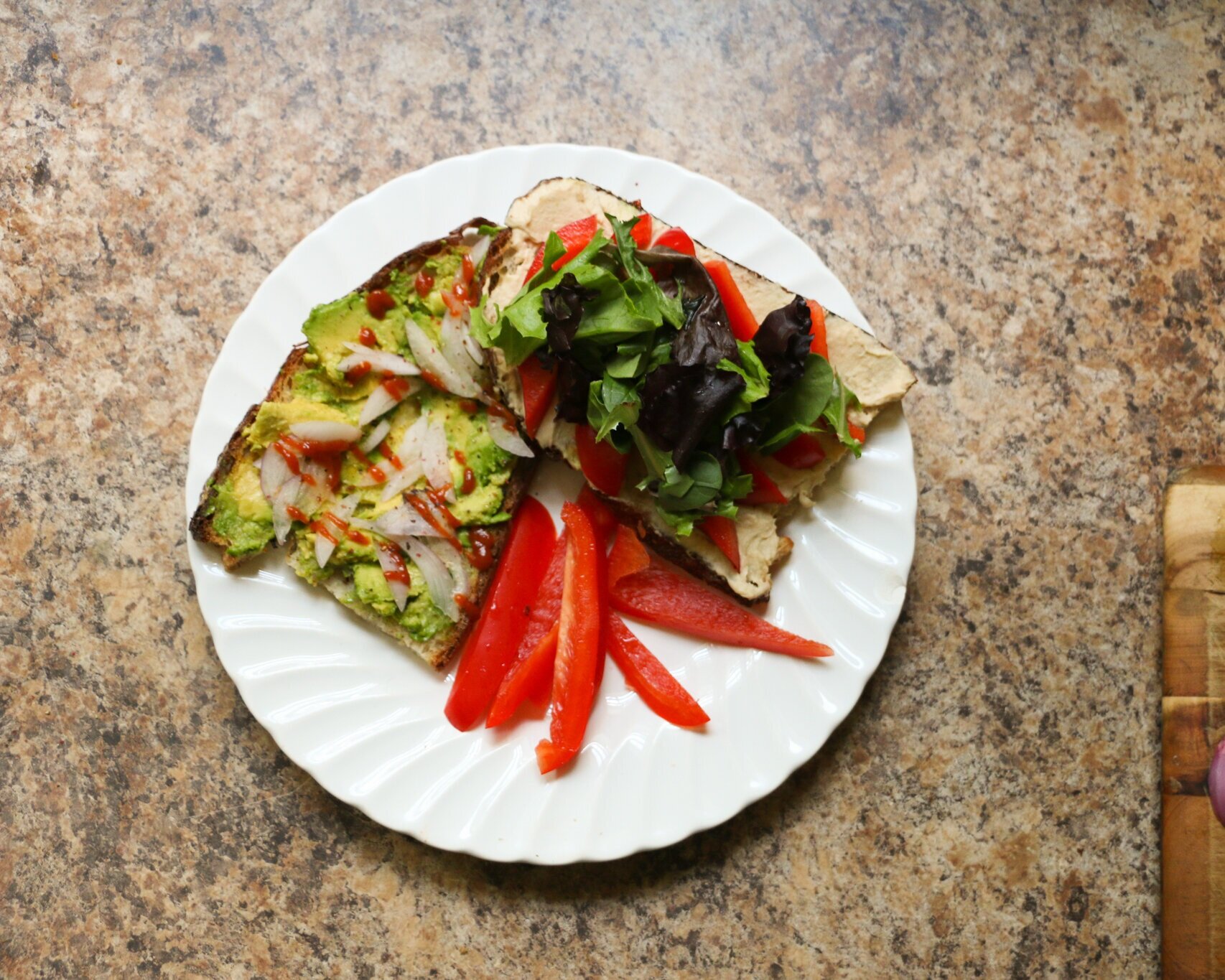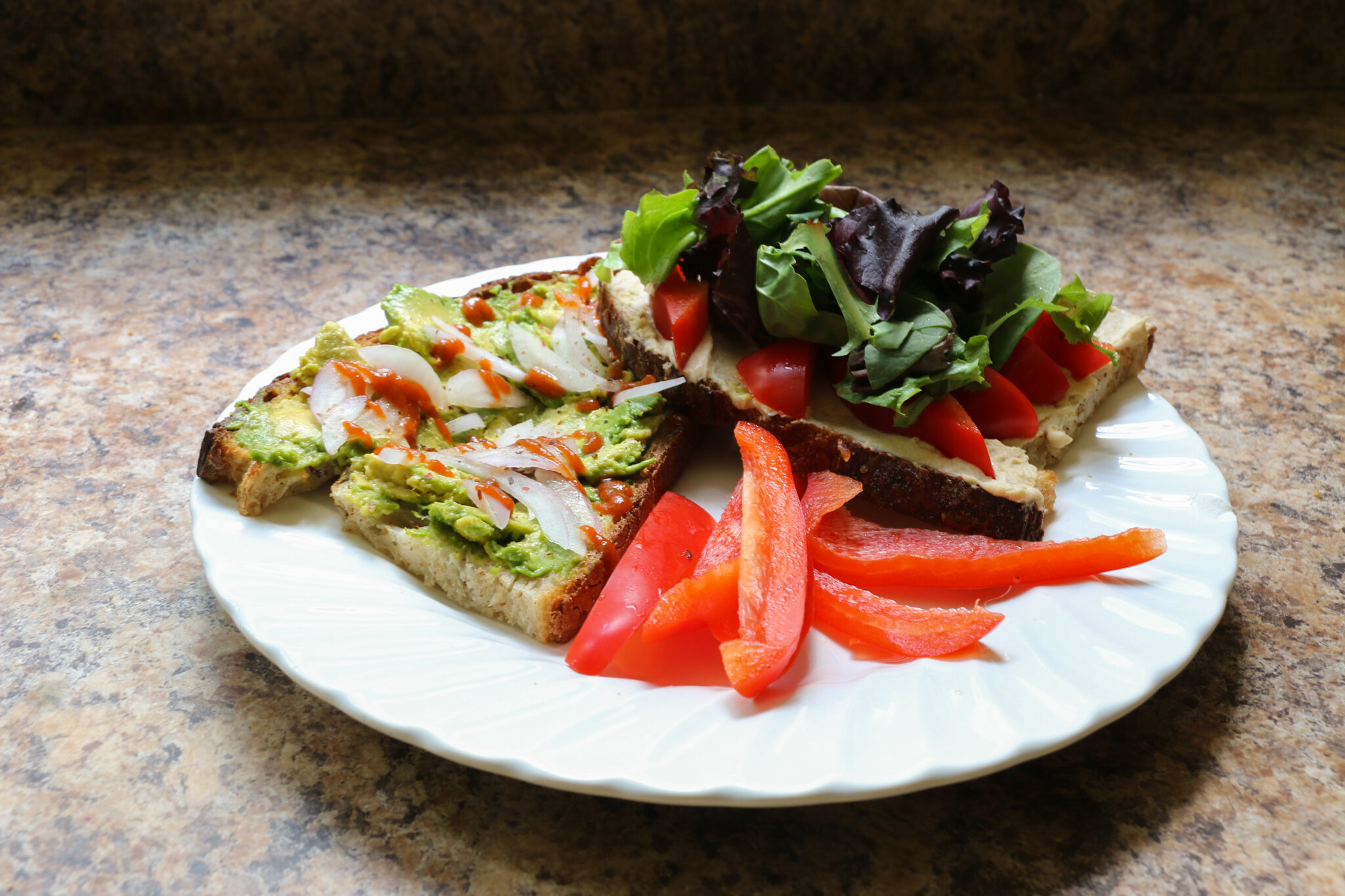Vegan Sandwich Guide
This guide was written by staff writer, Lily Falk. Read about Lily here.
As with any dish, a tasty sandwich combines contrasting but complementary textures and flavors to create a multi-faceted experience.
When dreaming of a vegan sandwich, try to mentally shift your thinking from a piece of animal protein and lettuce to a thick protein-rich spread, with crisp fresh lettuce, juicy tomato, and a hearty vegetable of your choosing. The opportunities are endless. Take these components of texture, flavor, and structure, in whatever direction you want. Go into your vegan sandwich experience with an open mind, and try incorporating some key points from below, but as with all cooking, when in doubt, keep it simple! From there, you can dress it up, but the three basic items below are often enough for me!
My essentials for a good sandwich include:
TOASTED bread: I enjoy fresh bread on its own with olive oil, but for a sandwich, I toast it every time. I think that the textural component of a crunchy outside, soft inside is key.
A spread, to hold it together: The spread often provides the fat and protein to balance and acidic or sweet flavors. That being said, spread like jam and mustard provides sugar and acid that can be balanced elsewhere in the sandwich.
Crisp fresh or roasted vegetables: Fresh tomato is a great option in the summer to provide salt and sweet acidity. Bell peppers are great when crisp, and lettuce greens provide a great texture. Mushroom and eggplant can provide a chewier experience for those craving a prominent bulk in the sandwich.
When it comes to balancing flavor, foods rich in fat are well complemented by acidic and sweet flavors. This is why sliced fresh tomatoes enhance hummus, and why bananas, honey, and jam are peanut butter essentials. This is also why those trendy pickled onions are a key to complete avocado toast.
Note the word toast in avocado toast. With these rich base layers, texture is key to round out the experience, and some level of crunch is essential for the foundation. In my opinion, bread for sandwiches should always be toasted. In addition, crisp and fresh leafy greens provide a direct contrast to any fat/protein-rich base layer - the fresh produce lightens the heavy, dense fat/protein-rich food.
Cooking vegan meals is analogous to writing with a different alphabet. I asked my friend (an omnivore), “If I told you to go make a vegan sandwich right now, what would you use?” She said, “Oh boy… Tofu? Is that vegan?”
Yes, tofu is vegan, and yes it can be delicious on a sandwich, but the options extend far beyond soy. If you don’t like tofu or are allergic to nuts, there are still many ways to incorporate vegan options into your regular lunch routine.
While I do love Impossible Food and various other store-bought veggie burgers/sausages, I do not eat these items regularly. In my mind, the key to being a vegetarian is to think of the expansive possibilities within the plant world, without necessarily drawing a direct comparison between a meat product and plant replication.
Structural Components
Bread
Considerations
Outer + inner textures
TOAST sandwich bread, please!
Thick slices create contrast between the stiff outer and soft center of the bread
Thin slices let the inside of the sandwich shine while maintaining soft or hard crunch on the outside
Air content + type of bubble formation
Fiber and protein content
Sticky and soft vs. dry and stiff
I would classify bread that is super soft untoasted as “sticky and soft” - they can easily be smooshed like a marshmallow (such as “Dave’s Killer Bread” and many shelf-stable sandwich bread from grocery stores)
Bread that is stiff and dry often has a tight crumb structure (such as “Ezekiel Bread”)
In baking, the small holes we say in our bread are the result of air bubbles that were produced and then trapped, and the amount and size of them is called “the crumb”. See an example of a large(er) crumb structure in the image below and a tight crumb structure in the image below that. Sourdoughs often have a larger crumb structure, while other bread with whole wheat content tends to have a tighter crumb. While a large crumb structure is delicious for toast, a tighter crumb structure prevents the sandwich from falling apart, so you have to choose your bread with this in mind!
Examples:
Sourdough
Not all are created equal, and their density and crumb can vary widely.
High-quality sourdough will have a slightly sweet aroma, light tang and a stickiness to the dough, as well as plenty of air bubbles/holes in the bread
Rolls - hamburger buns + hoagie/sub rolls
Whole wheat/grain/seed - pay attention to sweetness
Ezekiel sesame bread is one of my go-to sandwich breads for its lack of sweetness. While I do not particularly enjoy the bread on its own, when toasted it provides a great crunch for the base and allows all of the other flavors to shine through.
Spread
Considerations:
Smoothness: fat and protein provide richness that allows flavors to melt in your mouth
Spice: traditional spicy food as well as herbs that provide additional flavor
Tang/Sweet/Salt: from acid (citrus and vinegar), sugars (from fruits and vegetables, as well as honeys, syrups, and jams), and salt (both sea salt and salt that’s naturally occurring in foods like tomatoes, carrots, and beets)
Examples:
Spicy bean spread
Hummus
Avocado (note it can be a spread or a bulk)
Tahini - sweet and savory uses
Nut/seed butter
Almond butter
Peanut butter
Pili nut butter
Tahini
Just remember that with a vegan sandwich, the spread can provide enough bulk to make up the heart of the sandwich, but can also complement a roasted vegetable, veggie burger, or other hearty addition like falafel or egg (if you are not strictly vegan)!
Bulk
Considerations:
Texture: Crispness/Softness
Thickness
Examples:
Eggplant
Onion/pickled onions
Leafy greens
Tofu
Zucchini
Fruit: apple, pear, banana
Bell pepper
Tomato
Store-bought veggie burger if you’re in a pinch (though it’s still important to add spread to hold everything together!)
Roasted cauliflower
And, if you’re not vegan, add a lightly fried egg to literally anything! If you’re not a fan of a soft yolk, poke it with a spatula immediately after cracking it in the pan to cook it through
While the protein in many traditional American sandwiches can be found in this “bulk” of the sandwich (ike chicken, turkey, ham or cheese), vegan sandwiches don’t have to abide by the same rules. Let your bulk be whatever you want, if you want more protein, you can rely on a thick spread to provide that filling protein and fat from things like nuts, seeds, and legumes.
Bulk items can enhance vegan sandwiches, but are not essential, and need not replace the aforementioned spreads. To draw a flavor comparison, think of a classic hamburger. Few people would thoroughly enjoy a hamburger (the fat & protein alone) on a plain bun. Add ketchup and/or mustard (acidity and sweetness) as well as pickles (salt and crispiness) and the burger becomes substantially more enjoyable, but not yet something to brag about. Add onion (spice, crispiness, and sweetness) and lettuce (crispiness, freshness, and balance) and suddenly the burger is in the top-tier. This is one of the most critical differences when making vegan sandwiches: everyone can be the star of the show.
Finishing touches
Considerations:
Tang/acidity
Salt content
Spice: flavor and heat
Fat content: Olive oil drizzle, always a good call - try infused oils!
Examples:
Fresh basil/herbs
Black pepper
Drizzle of olive oil/vinegar: this one is particularly important
Glazes: these are great for sandwiches because they’re thicker and can help everything stay in place
Citrus: lemon, lime, orange, grapefruit
Example sandwiches
If you want to keep it simple, check out these below!
Tofu (use firm tofu to provide the “bulk”) with tomato sauce (Rao’s has amazing tang, salt and sweetness) on toast (Ezekiel provides the crunch)
Hummus (fat, protein, and even some tang depending on the recipe), avocado (bulk and fat to even out other flavors and provide some extra heft), tomato (tangy, sweet, and refreshing), and lettuce (crispiness) on sourdough. For extra flavor, try with Ben’s lemon tahini sauce!
Nut butter (fat to cut the sweet tang of the fruit) and fruit or jam (tang and sweetness) on any bread!
Hummus (fat, protein, smooth tangy bulk) with broccoli (hearty bulk), carrot (hearty bulk), onion (spice, crisp), and spring mix or arugula (crisp, freshness) on Ezekiel.
Below is an example of one of my favorite go-to lunches: a hummus sandwich with fresh greens and red pepper (though I also love tomatoes here). In this case, I added avocado to one half, as well as onion, black pepper, and sriracha. The soft, fatty flavor from the avocado balances out the spice from the onion and sriracha and also complements the slight tang from the hummus. The red bell pepper is both sweet and crisp, providing texture and freshness. In this example, I used spring mix, but generally, any salad green will work, and they’re essential for all of my meals
Another example below is a sandwich of well-toasted sourdough with tahini and raspberry jam. I prefer jam to jelly, and if served closed-face, I believe the textures combine best when a layer of seed butter rests on each side with the jam in the middle (as opposed to one full side of jam). This allows the fat to meld into the toast and keeps the inside of the sandwich goo-ey.
I hope that these components will help inspire you to experiment with new combinations, and if you are new to cooking or vegan cooking, will lead to an expansion of what you thought possible on a sandwich!
Related recipes
Spread: https://groundedgrub.com/recipes/lemon-tahini-everything-sauce
Bulk: https://groundedgrub.com/recipes/roasted-carrots-with-tahini-and-toasted-almonds
Spread: leftover thick soup can be a spread! - https://groundedgrub.com/recipes/hot-honey-butternut-squash-soup
Full sandwich-type (can pick and choose components): https://groundedgrub.com/recipes?category=Vegan
Spread: https://groundedgrub.com/recipes/tandoori-cashew-mash
Spread/finish: https://groundedgrub.com/recipes/leftover-herb-chimichurri
Bulk: https://groundedgrub.com/recipes/mushroom-white-wine-sauce
Burrito bulk: https://groundedgrub.com/recipes/tofu-crumble
Sandwich (tacos): https://groundedgrub.com/recipes/squash-bulgogi-tacos



